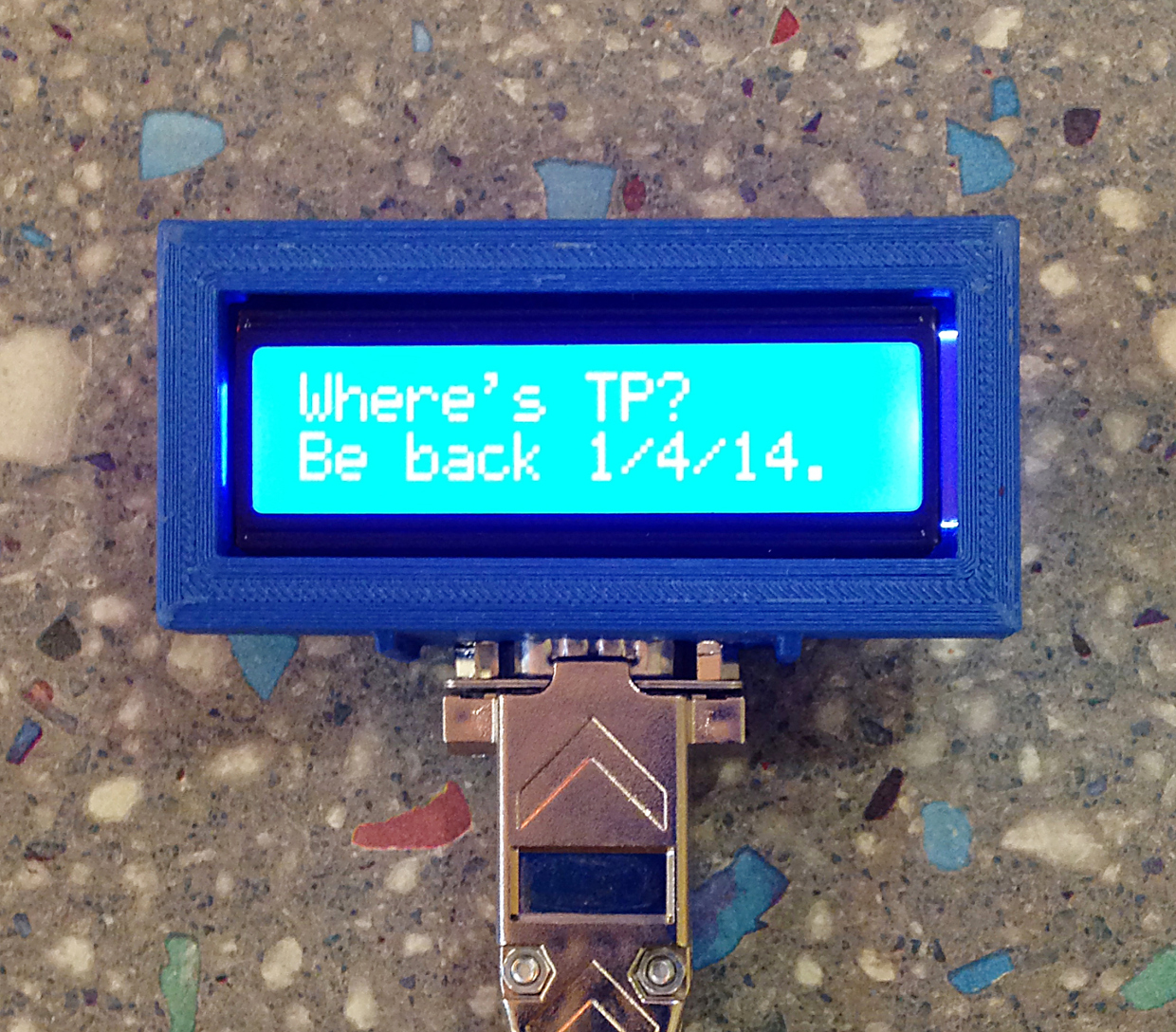Now that you separately have the GSM part working and the LCD part doing its thing, merge the two sketches. Or you can grab GSMTextMessage2LCD_modP.ino from repository that has it already done. For the hardware, if you already have the LCD connected from the GSM shield, then you are all set, otherwise put on the GSM shield and wire up using the pins shown in Step 1.
Setup() is pretty much the same as in the GSM test sketch. I did add additional diagnostics that show the cell carrier that connected and the signal strength. A few of the GSM startup messages that show up on the serial console (laptop display) were duplicated to show up on the LCD. This is helpful once the project is running on its own without the laptop connection.
// include the GSM library
#include
// include the LCD library
#include
// PIN Number for the SIM
#define PINNUMBER "" // "" means no PIN is used
/* initialize the library with the numbers of interface pins:
LCD RS pin to digital pin 12
LCD Enable pin to digital pin 11
LCD data pin D4 to digital pin 5
LCD data pin D5 to digital pin 4
LCD data pin D6 to digital pin 6 // changed for gsm shield
LCD data pin D7 to digital pin 8 // changed for gsm shield
*/
LiquidCrystal lcd(12, 11, 5, 4, 6, 8); // free pins when GSM shield used
// initialize the library instances
GSM gsmAccess;
GSMScanner scannerNetworks;
GSM_SMS sms;
char senderNumber[20]; // char array to hold the number a SMS is retreived from
char txtMsg[200]; // the text message char array
int numChars = 0; // number of characters in txtMsg
int validMessage = 0; // set to 1 when there is a message to display
char myCellNumber[] = "+XXXXXXXXXXX"; // used for message screening
void setup()
{
// initialize serial communications and wait for port to open:
Serial.begin(9600);
// set up the LCD's number of columns and rows
lcd.begin(16, 2);
// connection state
boolean notConnected = true;
// provide information to LCD as GSM gets started
lcd.print("GSM starting up ...");
// Start GSM connection
while(notConnected)
{
if(gsmAccess.begin(PINNUMBER)==GSM_READY)
notConnected = false;
else
{
lcd.setCursor(0,1); // format is col,row
lcd.print("Initializing...");
// delay(1000);
}
}
// currently connected carrier
Serial.print("Current carrier: ");
Serial.println(scannerNetworks.getCurrentCarrier());
lcd.clear();
lcd.setCursor(0,0);
lcd.print("Current carrier:");
lcd.setCursor(0,1);
lcd.print(scannerNetworks.getCurrentCarrier());
delay(1000);
lcd.clear();
// returns strength and ber
// signal strength in 0-31 scale. 31 means power > 51dBm
// BER is the Bit Error Rate. 0-7 scale. 99=not detectable
Serial.print("Signal Strength: ");
Serial.print(scannerNetworks.getSignalStrength());
lcd.setCursor(0,0);
lcd.print("Signal Strength:");
delay(1000);
lcd.setCursor(0,1);
lcd.print(scannerNetworks.getSignalStrength());
delay(2000);
lcd.clear();
// print one time message to the LCD
lcd.setCursor(0,0); // format is col,row
lcd.print("Where's TP?"); // first row
lcd.setCursor(0,1); // format is col,row
lcd.print("Waiting for SMS");
Serial.println("Waiting for SMS"); // Diagnostic
}
The Loop() now has two main sections: (1) check for and save new text messages and (2) print the valid text message to the LCD, scrolling as needed. The sketch checks for a new message each time through the code.
void loop()
{
char c;
int i; // char array index of txtMsg
int validMessage; // set to 1 when there is a message to display
// If there are any SMSs available()
if (sms.available())
{
// show on display that a text message has been received
lcd.setCursor(0,1); // format is col,row
lcd.print("SMS received");
delay(2000);
// Get remote number
sms.remoteNumber(senderNumber, 20);
Serial.println("Message received from:"); // Diagnostic
Serial.println(senderNumber); // Diagnostic
// Any messages not coming from my cell number should be discarded.
if( strncmp( senderNumber, myCellNumber, 12 ) != 0 ) // strncmp returns 0 if match of 12 chars
{
Serial.println("Discarded SMS"); // Diagnostic
sms.flush();
}
else {
// Read message bytes and save them
i = 0;
while( c = sms.read() ) {
Serial.print(c); // Diagnostic
// save the message character by character and keep track how many chars in message
txtMsg[i] = c;
i++;
validMessage = 1; // there is a valid message
}
numChars = i; // the number of characters in txtMsg
}
// Delete message from modem memory
sms.flush();
Serial.println("MESSAGE DELETED");
} // end of if sms.available section
if ( validMessage ) {
// now print the message to the LCD.
// if there is only one row, print it all at once, else
// do scrolling.
if ( numChars <= 16 ) {
for (i = 0; i < numChars; i++) {
lcd.setCursor(i, 1); // format is col,row
lcd.print(txtMsg[i]);
}
}
else {
// logic for how far to scroll
for ( int q = 0; q <= numChars - 16; q++) {
// print out just one char at a time, and repeat for each column
for (i = 0; i < 16; i++) {
lcd.setCursor(i, 1); // i prints to a column
lcd.print(txtMsg[i+q]);
if (q == 0 && i == 15) {
delay(1800); // time to read the starting 16 chars
}
}
delay(650); // time for the scroll delay
}
}
delay(1000); // time to hold the last line fragment
// blank out the display after the scrolling has completed to prepare repeat
for (i = 0; i < 16; i++) {
lcd.setCursor(i, 1); // format is col,row
lcd.print(' '); // blank out the second row
}
delay(2000); // time the display is blank
} // end of if validMessage section
}












